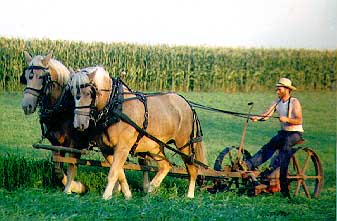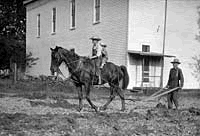

Agriculture


Years ago one could walk beside a
plowman and his team, and watch the
horses throwing their weight into their collars as the gleaming,
chocolate-colored slices of earth were turned up by the mold-board.
Although some ox-plowing teams were superseded by horses during the Middle
Ages, plowing with horses was not universal until the end of the 19th century
or later.
Horses had, however, been involved with agriculture from the
earliest days, harrowing behind the plow, harvesting wheat and taking grain to
the mill. The modern harvest lacks the splendor of the teams of Shires
or Percherons,
Suffolks
or Clydesdales, which drew the reaper-and-binder, or hauled
the sheaf-piled wagons to the stack yard. Like so many cart-horses their
era ceased before World War II. Even the ambling gait of the plowman is
no longer a familiar sight. Their curious walk was the result of hours
behind a plow with one foot in the furrow and the other on the up-turned
earth.
In the last fifty years or so the number of farm horses have
become greatly reduced, having been replaced by the tractor and combine
harvester. In Europe, and in France in particular, the horse is still a
more familiar sight than the tractor although how much longer this will continue
is really a matter of speculation.
Even with the highly mechanized farming methods of today, the
horse is still useful. Indeed, in some countries it is the tractor that is
a rare sight.
The cowboys in the West and the gauchos of South America
utilize the horse as their main means of transportation. Australia and New
Zealand also have large ranges where the horse has little fear of being
superseded in this technical age.
Heavy draft breeds like the Shire are often associated with agricultural work such as plowing. However, the very large draft breeds did not come into their own for this type of work until the end of the 18th century, when the invention of more sophisticated farm machinery required the use of horses that combined great physical strength with intelligence.